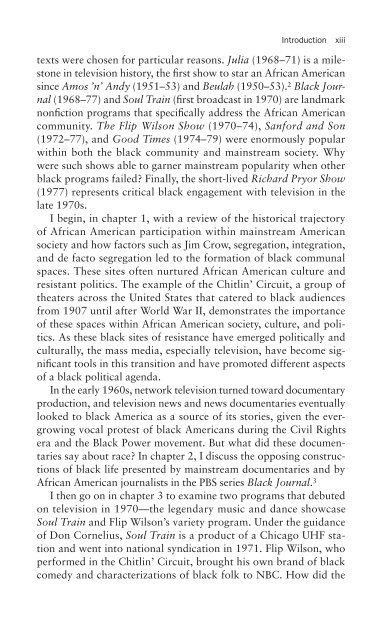Revolution Televised.pdf
Revolution Televised.pdf
Revolution Televised.pdf
Create successful ePaper yourself
Turn your PDF publications into a flip-book with our unique Google optimized e-Paper software.
Introduction xiii<br />
texts were chosen for particular reasons. Julia (1968–71) is a milestone<br />
in television history, the first show to star an African American<br />
since Amos ’n’ Andy (1951–53) and Beulah (1950–53). 2 Black Journal<br />
(1968–77) and Soul Train (first broadcast in 1970) are landmark<br />
nonfiction programs that specifically address the African American<br />
community. The Flip Wilson Show (1970–74), Sanford and Son<br />
(1972–77), and Good Times (1974–79) were enormously popular<br />
within both the black community and mainstream society. Why<br />
were such shows able to garner mainstream popularity when other<br />
black programs failed? Finally, the short-lived Richard Pryor Show<br />
(1977) represents critical black engagement with television in the<br />
late 1970s.<br />
I begin, in chapter 1, with a review of the historical trajectory<br />
of African American participation within mainstream American<br />
society and how factors such as Jim Crow, segregation, integration,<br />
and de facto segregation led to the formation of black communal<br />
spaces. These sites often nurtured African American culture and<br />
resistant politics. The example of the Chitlin’ Circuit, a group of<br />
theaters across the United States that catered to black audiences<br />
from 1907 until after World War II, demonstrates the importance<br />
of these spaces within African American society, culture, and politics.<br />
As these black sites of resistance have emerged politically and<br />
culturally, the mass media, especially television, have become significant<br />
tools in this transition and have promoted different aspects<br />
of a black political agenda.<br />
In the early 1960s, network television turned toward documentary<br />
production, and television news and news documentaries eventually<br />
looked to black America as a source of its stories, given the evergrowing<br />
vocal protest of black Americans during the Civil Rights<br />
era and the Black Power movement. But what did these documentaries<br />
say about race? In chapter 2, I discuss the opposing constructions<br />
of black life presented by mainstream documentaries and by<br />
African American journalists in the PBS series Black Journal. 3<br />
I then go on in chapter 3 to examine two programs that debuted<br />
on television in 1970—the legendary music and dance showcase<br />
Soul Train and Flip Wilson’s variety program. Under the guidance<br />
of Don Cornelius, Soul Train is a product of a Chicago UHF station<br />
and went into national syndication in 1971. Flip Wilson, who<br />
performed in the Chitlin’ Circuit, brought his own brand of black<br />
comedy and characterizations of black folk to NBC. How did the

















